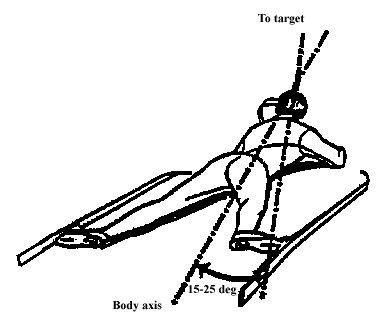| |
| |
There are two positions that you shoot from in Biathlon competitions: Prone position, illustrated in Figure 1, and Standing position (also sometimes referred to as the Offhand position), which is illustrated in Figure 2. In order to maximize your shooting score in both positions, you must pay attention to the following shooting fundamentals, which are presented below. All the illustrations are clickable.
| |
| |
By positioning, I mean getting your body in a position to support the rifle in such a way that it's movement is minimized - be it by your breathing, the force of gravity, the wind, or your heartbeat. Mechanically sound positioning is the foundation for good shooting. Though the exact position you adopt will vary somewhat depending on your physique, in general you are trying to position your body and rifle in such a way that you form triangles in as many directions as possible. The reason you work for triangles is because this is the most rigid shape possible, as clicking here and studying the drawing should show. In addition you are trying to use your skeletol structure as much as possible - your bones are much more rigid and stable than your muscles can ever be.

|
| |
When you drop down into prone shooting position, you will be lying on your stomach, with the axis of your body angled a little to the right of the line to the target, as shown in Figure 3. (This assumes you are right-handed.) Your shoulders should be square with your spine; your spine should be straight. Your legs should be comfortably spread in a "V", with toes pointed out. Some people bend the right knee a little - that is a personal preferance.
Your right arm should be as shown in Figure 4 - notice that the upper arm, torso, and the ground forms a triangle, providing lateral stability.
The rifle butt should be pressed firmly into your right shoulder as shown in Figure 5. Again note the triangle formed by the upper arm, lower arm, and the rifle stock.
Your left arm should be positioned with the palm of the hand positioned somewhere along the hand rail, as shown in Figure 6.
| |
|
||
| |
|
|
|
| | |
| | |
The general stance for Off hand shooting is illustrated in Figure 7. Your left shoulder should be towards the target. Your feet should be roughly shoulder width apart. Your knees should be straight, but not tense or locked backwards. You should have roughly equal weight on both feet. The rifle butt should be positioned fairly high on the right shoulder, and your right arm should be out - as illustrated in Figure 8.
| |
| |
On most biathlon rifles that you will encounter - e.g. the Anshutz and Marlin rifles, you will be using what is called a "peep" sight. With your eye positioned directly behind the rear sight and roughly an inch or two back from the eyecup as shown in Figure 5, you should line up the target so that it forms concentric circles with the front and rear sights, as shown in the stylized peep sight in Figure 9. For repeatability in positioning, you should have the cheek bone pressed against the side of the rifle stock. Don't squint. Try to keep both eyes open - use an eye patch if necessary.
You want to have your body aligned in such a way that the rifle naturally points at the target. You should not be using your muscles to force the rifle into position. A good way to check for proper alignment is to shift your body and hand position slightly to line the target up in the sight, then closing your eye for a few seconds. When you open your eye, the target should still be in the sight. If it is not, you need to adjust the position a little more.